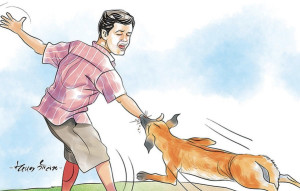Columns
How Nepal’s hydro betrayed its farmers
The country must rapidly modernise and mechanise its agriculture to improve economic growth.
Bishal Thapa
Food, water and energy; these three were once considered to be the secret sauce to Nepal’s economic growth, livelihoods and security. They are now the sources of new vulnerabilities that are deeply altering Nepal’s social and economic landscape.
The abundance of water and energy, the pride of Nepal, is not being positioned to address food vulnerabilities. Instead, they are being repurposed for other things, in part because there is not enough attention being paid to the issue of food security. Nepal must rapidly address these vulnerabilities.
Growing food imports
Nepal remains a deeply agrarian economy with 61 percent of the population still working in the farming sector. Unfortunately, those working in agriculture have fared poorly. Between 1991 and 2021, for example, the real per capita income in agriculture increased by only one percent on average, a dismal rate of growth. Over that same period, the share of agriculture in gross domestic product (GDP) has declined from 48 percent to 21 percent.
Remittance, currently accounting for approximately 26 percent of GDP, far exceeds the income from agriculture. We may still be a country of farmers, but our farmers are forced to work in the fields and factories of other countries.
The impact of declining agricultural productivity and profitability is already showing up in Nepal’s food vulnerability. In the last fiscal year 2024-2025, Nepal imported Rs360 billion (approximately $2.57 billion) of food products. Just two decades earlier, in 2001, Nepal’s agricultural imports were merely $12 million.
Agricultural products account for approximately a fifth of total imports, adding to Nepal’s growing trade deficit. Rice, fruits, vegetables and staple food alone account for 30 percent of farm products being imported.
Declining agricultural land
The decline in agricultural land is another factor compounding Nepal’s food vulnerabilities. Agricultural land has been declining by 1.75 percent annually on average, a study by the Forest Research and Training Centre (FRTC) under the Ministry of Forests and Environment found in its December 2024 report.
For the half-century between 1970 and 2023, agricultural land in Nepal faced a bell-shaped growth pattern, rising to a peak in 2000 and dropping sharply thereafter. The doubling of Nepal’s forest and the highly trumpeted successes of community-managed forests should be considered in the context of declining agricultural land.
Nepal’s forest cover has doubled over just the last two decades and now represents approximately 46 percent of the total land. This growth in Nepal’s forest cover has been widely acclaimed nationally and internationally. The New York Times, for instance, has devoted several articles to documenting the success of Nepal’s community-managed forests and other initiatives in achieving this growth.
While the growth of Nepal’s forest cover is being celebrated—and there is certainly a lot to celebrate—the loss of agricultural land is growing relatively unnoticed. To some extent, the growth in forest cover is a result of the decline in agricultural land and livestock farming.
The fact that growth in forest cover is celebrated without acknowledging how that might portend an equally worrisome trend in the decline of agricultural land is an illustration of how Nepal’s food vulnerabilities are being overlooked.
The decline in agricultural productivity, profitability and land are all swirling together in an era of rising food prices, increased climate risks and emigration to create one of the most dangerous vulnerabilities for Nepal. This risk must draw greater attention than it currently does.
Abundant water, no infrastructure
Nepal still has an abundant water supply, though some areas are beginning to report increased water scarcity. Several factors are contributing towards that stress: Urbanisation, lack of infrastructure and groundwater depletion. Urban centres, such as Kathmandu, routinely report water stress from scarcity of drinking water. Many parts of Nepal are still reliant on natural springs, making them highly susceptible to geological shifts. Some estimates suggest that approximately 5,000 natural springs may have dried up after the earthquake in 2015.
Only about 40 percent of the agricultural land has access to irrigation. The rest rely on rainfall, making them highly vulnerable to erratic weather patterns from climate change. Although groundwater level is still adequate to sustain a higher level of agriculture in the Terai, declining agricultural profitability has meant that farmers are reluctant to invest in pumping and other irrigation options.
The abundance of water in Nepal should have been able to mitigate against the risks to agriculture, providing a key ingredient to buffer against increased climate and competitive pressures. Without the infrastructure to bring water to the field and irrigate them, the water supply is reduced to the options of streams, springs or underground sources. The abundance of water without the associated irrigation infrastructure has hobbled Nepal’s agriculture and compounded food vulnerabilities.
Unfilled promise of energy
The only answer to Nepal’s food vulnerability is electrification and mechanisation of agriculture. Nepal may be well-suited for this with a large base of electricity generation that is reportedly significantly higher than demand.
But where is the electricity to power this electrification and mechanisation in agriculture? Earlier this week, Nepal secured an agreement to sell an additional 200 megawatts(MW) to India, taking the total level of potential exports to 1,140 MW. These exports will no doubt earn Nepal several billion rupees.
But those exports are very expensive for Nepali farmers. The absence of reliable electricity is undermining the transition to increased agricultural productivity and profitability through electrification, modernisation and mechanisation.
The lack of energy for agriculture is at the heart of Nepal’s food vulnerability. Nepali agriculture has remained trapped in traditional methods almost entirely because electricity has not been available to drive the transition to modern and mechanised methods.
Energy use in Nepal’s agriculture remains exceedingly low, approximately 22 kilograms of oil equivalent per agricultural work in 2021. Other developing countries use approximately four times that energy input in agriculture, suggesting much higher levels of mechanisation than in Nepal.
For Nepal to overcome its food vulnerability, the power sector must also be able to take advantage of improved electricity supply to the farmlands. Transmission and distribution infrastructure feeding rural and agricultural areas must be significantly strengthened—they are currently too weak and outdated to support widespread mechanisation in agriculture.
Not enough investments are flowing to improve the quality of transmission and distribution infrastructure in rural agricultural areas. Electricity access alone is not enough. The distribution network serving these areas must be enhanced and modernised.
So, here is the irony of Nepal’s food vulnerability in the context of Nepal’s power exports to India.
With the most recent hydro power export deal, Nepal will sell electricity to Haryana, an agriculturally rich Indian state. Haryana’s farmers will use the electricity from Nepal to pump water to cultivate rice. Haryana’s farmers will use Nepal’s electricity to hull the rice, polish it and sack it. That Haryana rice will be imported to Nepal, where Kathmandu’s power sector elites and decision makers will eat it while celebrating the export of electricity to India.
It will be a yummy feast only for those eating.




 19.12°C Kathmandu
19.12°C Kathmandu















